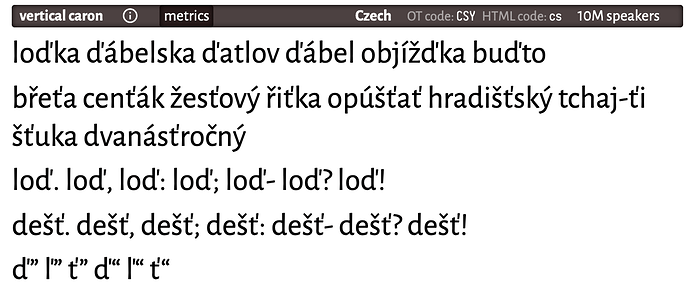Trying to keep the number of kerning pairs low, I wonder which characters are likely to follow after dcaron, lcaron, tcaron in Czech/Slovak or other languages.
I know there’s no need for a kerning pair dcaron/germandbls, but I am not sure which diacritics should be kerned with vertical caron.
for example: dcaron with /aacute/abreve/acircumflex/adieresis/agrave/amacron/aring/atilde – do I need to kern all of these, or are there some pairs which do not occur in any language?
Is there a list about »unnecessary kerning pairs« that can answer this and similar questions?
If so, where can I find this?
That’s easy to find with https://underware.nl/latin_plus/character_set/
Just click on the character and see what other letters appear in languages it is used in.
oh, I was not aware of the »leftish/rightish friends« in latin plus – this is perfect, thanks a lot!
Please note, those letters are often last letters of a word (déšť, loď, hôľ), therefore you should include punctuation in the kerning to avoid collision: buď! loď? voliť) etc.
I found a shared link on Twitter yesterday pointing to this wonderful testing environment, with specific language ‘Gotchas’ or niche-use scenarios, as well as a myriad of other contexts and information: https://bulletproof.italic.space
I have this line in Preferences > Sample Strings:
nď, ď. ď: ď; ď! ď? (ď) [ď] {ď} ‘ď’ „ď“ ‚ď‘ ď*\nnďa ďá ďh ďk ďl ďm ďn ďo ďt ďu ďž\n\nnľ, ľ. ľ: ľ; ľ! ľ? (ľ) [ľ] {ľ} ‘ľ’ „ľ“ ‚ľ‘ ľ*\nnľa ľb ľč ľg ľh ľk ľm ľn ľň ľo ľs ľš ľt ľu ľú ľv\n\nĽ, Ľ. Ľ: Ľ; Ľ! Ľ? (Ľ) [Ľ] {Ľ} ‘Ľ’ „Ľ“ ‚Ľ‘ Ľ*\nĽa Ľb Ľč Ľg Ľh Ľk Ľm Ľn Ľň\nĽo Ľs Ľš Ľt Ľu Ľú Ľv\nĽA ĽB ĽČ ĽG ĽH ĽK ĽM ĽN ĽŇ\nĽO ĽS ĽŠ ĽT ĽU ĽÚ ĽV\n\nnť, ť. ť: ť; ť! ť? (ť) [ť] {ť} ‘ť’ „ť“ ‚ť‘ ť*\nnťa ťá ťc ťd ťj ťk ťm ťn ťo ťr ťs ťt ťu ťž
I derived it from a text analysis of a bunch of Czech and Slovak books I found online.
Several of those combinations are in the default sample strings already.

